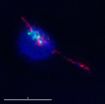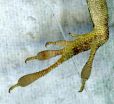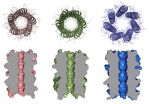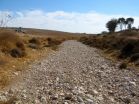(Press-News.org) Kansas City, MO. — The development of a new organism from the joining of two single cells is a carefully orchestrated endeavor. But even before sperm meets egg, an equally elaborate set of choreographed steps must occur to ensure successful sexual reproduction. Those steps, known as reproductive cell division or meiosis, split the original number of chromosomes in half so that offspring will inherit half their genetic material from one parent and half from the other.
During meiosis, each set of homologous chromosomes pair up in a kind of chromosomal square dance, chromosome 1 with chromosome 1, 2 with 2, and so on down the line. The partners stick together, dancing through the phases of meiosis, until it is time to segregate or separate to opposite ends of the dividing cell. When the dancers don't pair or part appropriately it can result in eggs and sperm with the wrong number of chromosomes, a major cause of miscarriage and birth defects.
To avoid these mistakes, most chromosomes use a process known as crossing over, looping their arms with their partners and even swapping pieces of genetic material to stick together until the dance is over. A few chromosomes, like chromosome 4 in the fruit fly Drosophila melanogaster, are too short to make these crossovers. Yet somehow, they have figured out another way to stay connected to their partners.
Previously, Stacie E. Hughes, Ph.D., a research specialist II at the Stowers Institute for Medical Research, identified thin threads of DNA that seemed to tie these other homologous chromosomes together. Yet a major question remained: once these chromosomes are roped into pairs, how do they manage to come apart again?
Now, Hughes and R. Scott Hawley, Ph.D., have shown that an enzyme called Topoisomerase II is required for resolving these threads so homologous chromosomes can part ways. The finding, published in the October 23, 2014 issue of PLoS Genetics, underscores the complexity of the meiotic process.
"It is not surprising there are many ways to segregate chromosomes because there are also many ways to control other molecular events, like gene expression," says Hawley, a Stowers Institute investigator and American Cancer Society research professor. "This method of segregating shorter chromosomes may be clunky, odd, crazy, and as noncanonical as it gets, but that doesn't matter, because the cells survive. In the end, these processes don't have to be elegant, they just have to work."
Ever since Hughes' initial discovery of DNA threads, she and Hawley have been looking for the molecular scissors responsible for cutting entangled chromosomes free. The most prominent candidate to emerge from their search was Topoisomerase II, an enzyme known to cut and untwist tangled strands of the double helix.
Previous research had shown that Topisomerase II was involved in earlier cellular processes like DNA replication, and the enzyme was still detectable even during later phases of meiosis. The researchers thought that Topoisomerase II might be waiting around to do yet another job, cutting DNA threads to allow homologous chromosomes to segregate.
Testing their hypothesis seemed relatively straightforward. The researchers simply needed to "knock out" Topoisomerase II in their model organism of choice - the female fruit fly - and then look to see whether meiosis was able to proceed normally without it. However, because the enzyme was involved in so many critical cellular processes, the researchers knew that such an approach would yield nothing more than dead fruit flies.
Instead, they adapted a sophisticated method known as RNA interference - which uses small pieces of DNA's chemical cousin RNA to silence genes - and eliminated Topoisomerase II at a specific time point late in meiosis. Hughes then isolated the oocytes from the fruit flies and analyzed them using fluorescent tags that illuminate the DNA threads connecting the chromosomes. Their findings were dramatic.
"Without this enzyme the chromosomes can't come apart, they are stuck together like glue," says Hughes. "There are large regions of the chromosomes that are tethered together by these threads, while the rest is stretched out like a slinky as the chromosomes are pulled in opposite directions. It is just a mess. Because the chromosomes are just stuck there, they can't finish meiosis."
As a result, the mutant flies are essentially sterile. A separate study published in the same journal shows that male mutants experience a similar fate, their spermatocytes permanently locked in an immature state. Without Topoisomerase II, the oocytes and spermatocytes are locked in meiosis, unable to complete the next steps - fertilization, cell division and differentiation - needed to create a new organism.
INFORMATION:
The work was funded in part by the Stowers Institute for Medical Research and the American Cancer Society (award number RP-05-086-06-DDC).
Lay Summary of Findings
During the formation of eggs and sperm, the cell's chromosomes must pair up and part in an elaborate sequence that results in sex cells with exactly half the number of chromosomes as the parent cell. A single misstep can cause infertility, miscarriage, and birth defects. Recent research has shown that some chromosomes avoid these mistakes by using thin threads of DNA to tether themselves together, but how they come untied again has not been clear. In the current issue of the scientific journal PLoS Genetics, Stowers Institute scientists report that an enzyme called Topoisomerase II is required for these entangled chromosomes to be set free. Stowers Research Associate II Stacie E. Hughes, Ph.D., who led the study, explains that without the enzyme, female fruit flies were unable to complete meiosis and were rendered completely sterile. Topoisomerase II likely resolves the DNA entanglements by cutting and untwisting tangled DNA, as in other processes like DNA replication.
About the Stowers Institute for Medical Research
The Stowers Institute for Medical Research is a non-profit, basic biomedical research organization dedicated to improving human health by studying the fundamental processes of life. Jim Stowers, founder of American Century Investments, and his wife, Virginia, opened the Institute in 2000. Since then, the Institute has spent over 900 million dollars in pursuit of its mission.
An international team of researchers from Japan and the UK has discovered how a single protein, called PP4, oversees the processing of DNA during sperm and egg generation for successful fertilization. This protein's activity becomes even more paramount during aging. The study, published in the journal PLOS Genetics, may one day help scientists to understand the mechanisms underlying age-related fertility declines in humans.
While a typical adult human cell contains 46 DNA strands, or chromosomes, that carry our complete genetic information, reproductive cells such as ...
Research conducted at the highest-altitude Pleistocene archaeological sites yet identified in the world sheds new light on the capacity of humans to survive in extreme environments.
The findings, to be published in the Oct. 24 edition of the academic journal Science – co-authored by a team of researchers including University of Calgary archaeologist Sonia Zarrillo – were taken from sites in the Pucuncho Basin, located in the Southern Peruvian Andes.
The primary site, Cuncaicha is a rock shelter at 4,480 metres above sea level, with a stone-tool workshop ...
Scientists working on islands in Florida have documented the rapid evolution of a native lizard species — in as little as 15 years — as a result of pressure from an invading lizard species, introduced from Cuba.
After contact with the invasive species, the native lizards began perching higher in trees, and, generation after generation, their feet evolved to become better at gripping the thinner, smoother branches found higher up.
The change occurred at an astonishing pace: Within a few months, native lizards had begun shifting to higher perches, and over ...
When a solid material is immersed in a liquid, the liquid immediately next to its surface differs from that of the bulk liquid at the molecular level. This interfacial layer is critical to our understanding of a diverse set of phenomena from biology to materials science. When the solid surface is charged, just like an electrode in a working battery, it can drive further changes in the interfacial liquid. However, elucidating the molecular structure at the solid-liquid interface under these conditions has proven difficult.
Now, for the first time, researchers at the US ...
Ferns are believed to be 'old' plant species – some of them lived alongside the dinosaurs, over 200 million years ago. However, a group of Andean ferns evolved much more recently: their completely new form and structure (morphology) arose and diversified within the last 2 million years. This novel morphology seems to have been advantageous when colonising the extreme environment of the high Andes.
Dr Patricia Sanchez-Baracaldo (Bristol) and Dr Gavin Thomas (Sheffield) used molecular and morphological data to study a group of ferns which grow in a unique ecosystem ...
Proteins are long linear molecules that fold up to form well-defined 3D shapes. These 3D molecular architectures are essential for biological functions such as the elasticity of skin, the digestion of food, and the transport of oxygen in blood.
Despite the wide variety of tasks that natural proteins perform, they appear to use only a limited number of structural types, perhaps just a few thousand or so. These are used over and over again, being altered and embellished through evolution to generate many different functions. This raises the question: are more protein ...
A Dartmouth study suggests that it may be possible to use Diffuse Optical Spectroscopic Tomographic imaging (DOST) to predict which patients will best respond to chemotherapy used to shrink breast cancer tumors before surgery. These findings could eliminate delays in effective early treatment for tumors unlikely to respond to neoadjuvant chemotherapy (NAC). The study, "Predicting breast tumor response to neoadjuvant chemotherapy with Diffuse Optical Spectroscopic Tomography prior to treatment," was published online in Clinical Cancer Research on October 7, 2014.
Breast ...
BOSTON - New achievements in synthetic biology announced today by researchers at the Wyss Institute for Biologically Inspired Engineering, which will allow complex cellular recognition reactions to proceed outside of living cells, will dare scientists to dream big: there could one day be inexpensive, shippable and accurate test kits that use saliva or a drop of blood to identify specific disease or infection — a feat that could be accomplished anywhere in the world, within minutes and without laboratory support, just by using a pocket–sized paper diagnostic ...
(Santa Barbara, Calif.) — Volatile rainstorms drive complex landscape changes in deserts, particularly in dryland channels, which are shaped by flash flooding. Paradoxically, such desert streams have surprisingly simple topography with smooth, straight and symmetrical form that until now has defied explanation.
That paradox has been resolved in newly published research conducted by Michael Singer and Katerina Michaelides, associate researchers at UC Santa Barbara's Earth Research Institute. The pair show that simple topography in dryland channels is maintained ...
DALLAS – Oct. 23, 2014 – A hormone seen as a popular target to develop weight-loss drugs works by directly targeting the brain and triggering previously unknown activity in the nervous system, UT Southwestern Medical Center obesity researchers have found.
The fibroblast growth factor 21 (FGF21) hormone has been a key target for developing weight-loss drugs because the protein increases energy expenditure, causing the body to burn calories. But how the hormone worked wasn't known until now.
UT Southwestern researchers tracking the hormone discovered that ...







